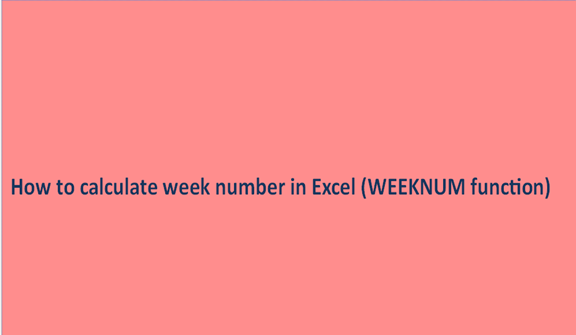Microsoft Excel offers various functions that enable users to work with days, months, and years. However, of all these, only one is designed for weeks – the WEEKNUM function. Hence, if you are looking for means or access to a week number from a date, WEEKNUM is your exact search.
Based on the WEEKNUM as mentioned earlier function, we shall be giving a brief but very clear, simplified, and -educative explanation in this write-up or manual on how the WEEKNUM function works. This is in addition to few examples illustrating how this function can be used to calculate operations involving week numbers in your Excel package.
An analysis of the WEEKNUM function in Excel
The week number of a particular year, i.e. ( numbers ranging from 1-54), can be returned using the WEEKNUM component of the Excel package. Concerning this, two arguments are involved. The first is necessary, while the 2nd is a matter of choice.
These two arguments are
1. The WEEKNUM Serial Number and
2. The WEEKNUM Return Type
WEEKNUM Serial Number – a number you are looking for that is a day of the week. A cell that has the date in it could serve as a reference, and a date inputted when you use the DATE component or return using other means of a formula.
Return _ Type (Optional) – a number that ascertains the particular day a week starts or commences. If not included, the default type 1 (which starts a new week on Sunday)can substitute.
Below is a list of accessories attached to the return_type found in WEEKNUM formulas.
There are two numbering systems of weeks made used of in the WEEKNUM function:
System 1:
The first week of January (containing January 1) is numbered Week 1 in the WEEKNUM function. This is because it is being seen as the 1st week of the year, and it starts originally on a Sunday.
System 2:
The System 2 numbering system is popularly known as the European week numbering system. The week commences on Monday, and the week that includes the first Thursday of the year is numbered as week 1. It is called the ISO week date system and is also a part of the ISO 8601 date and time system. It is commonly used by the government and business enterprises in calculating fiscal year and also for timekeeping.
The above-listed return types are applicable to System 1, excluding return type 21, which System 2 uses.
Note: When earlier Excel packages were first launched (Excel 2007 and others), Options I and Option 2 were the only options on the ground for use. Subsequent packages, i.e., Excel 2010 and Excel 2013, later featured Return type 11 through 21.
How to get week numbers from dates is being represented in the following screenshot = WEEKNUM (A2) formula:

In the above formula, the return_type argument is omitted, which means that the default type 1 is used – the week beginning on Sunday.
On the other hand, if you want to start with other days of the week, e.g., Monday, then 2 should be made use of in the second argument.
=WEEKNUM(A2, 2)
By making use of the DATE function (year, month, and day), the date can be reflected directly on the formula saving you the stress of making reference to a cell.
=WEEKNUM(DATE(2015,4,15),2)
16 is being returned as a number of the week in which April 15, 2015, is being contained, with a week that commences from Monday in the above formula.
In our everyday activities, the WEEKNUM function of the Excel package is scarcely made use of alone. It is often combined with other Excel packages to carry out different calculations attached to the week number, as shown in more examples.
